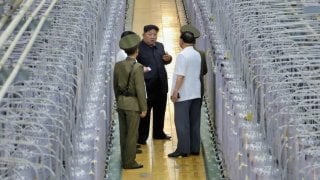Kim Jong-un’s Nuclear “Show and Tell” Should Lead to a Washington Rethink
The reassessment that is required would question fundamental assumptions about U.S. North Korea policy and honestly weigh the options now on the table.
The North Korean problem suddenly got a lot worse last month when Kim Jong-un unveiled a new uranium enrichment plant capable of producing weapons-grade uranium for nuclear warheads. Pyongyang has also resumed testing of cruise and ballistic missiles, firing off a new strategic cruise missile as well as a super-large warhead ballistic missile.
The location of the enrichment facility was not revealed, although some speculated that it was near the North’s existing nuclear complex at Yongbyon. The Korean Central News Agency (KCNA) showed photos of Kim walking between shoulder-high rows of centrifuges used to produce weapons-grade enriched uranium.
North Korea Expands Uranium Production.
Estimates vary, but some analysts think North Korea may be able to produce enough uranium for as many as 200 nuclear weapons by 2027. Production from the new centrifuge facility would add to this amount. During his visit to the enrichment plant, Kim called for a massive expansion of the North’s nuclear capability. The centrifuges apparently have a new, more efficient design, which will require estimates of North Korea’s nuclear capability to be revised upwards. Exactly when the new enrichment facility came online remains unclear, although it appears to be relatively new.
Kim visited the enrichment facility on Friday, September 11. Although the location of the facility was not disclosed, there has been speculation that it is near the North’s main nuclear complex at Yongbyon. A group of American academics led by Stanford University’s Siegfried Hecker visited the facility in 2010.
Not long after Kim’s visit, KCNA reported that Pyongyang fired two new missiles into the Sea of Japan; one was a Hwasongpho-11 Da-4.5, and the other was an upgraded cruise missile. The first missile was designed to carry a super-large conventional warhead, while the second was described as “strategic,” apparently a code word for a nuclear warhead.
Kim Jong-un personally supervised both tests. Unlike in the past, he was not accompanied by his daughter, who has often appeared with him on military-related appearances. At the missile tests, Kim was quoted as saying that the current international situation required Pyongyang to prioritize military strength.
South Korea Reacts by Considering Nuclearization
Seoul reacted to the KCNA photos of the enrichment plant in a predictably alarmist fashion. Coming after the missile and nuclear tests, they only reinforced public support for a policy of nuclear latency, that is, developing the technological capacity to go right up to the line of having its nuclear weapons. According to public opinion polls, over 70 percent of the South Korean public is willing to support expanding nuclear capabilities without actual production, presumably to avoid creating problems with the United States.
The Biden administration seems incapable of developing any new strategy toward North Korea. Former president Donald Trump is making friendly gestures to Kim Jong-un, saying that he can solve the North Korean nuclear problem with a few phone calls. It is not clear what Trump’s strategy would be. Vice President Kamala Harris, on the other hand, is repeating stale Biden White House talking points on the campaign trail, with the presidential election less than three weeks away at the time of writing.
The Next Administration Needs a Rethink on North Korea
Among policy specialists in Washington, there is an emerging consensus around the need for the next U.S. administration to rethink its core goals regarding North Korea. A myriad of DC experts have argued that demanding denuclearization as the U.S. precondition has precluded potential de-escalation or arms control agreements. Valuable deals and agreements on missiles, proliferation, and stopping or shrinking the DPRK nuclear weapons program, among other goals, could be on the table.
However, acknowledging North Korea’s nuclear status is not a policy rethink. It is a long overdue recognition that U.S.-stated goals and rhetoric are unrealistic and counterproductive. As far back as 2007, former South Korean president Kim Dae-jung told a top-level group of intelligence, diplomatic, and academic officials in Washington that the United States “wasted seven years” since the Bush administration had reversed U.S. policy, abandoning diplomacy, and relying only on coercion and sanctions.
The rethink that is required would question fundamental assumptions and honestly assess the realistic options that are now on the table. This should have been the daily responsibility of intelligence agencies. If given the leadership and flexibility to do their jobs, perhaps they would now come up with actionable ideas for the new team to consider.
Any new administration that strives to be successful in northeast Asia could begin by listening to the negotiator who had so much to do with the last successful deal, the 1994 Agreed Framework.
Noting the need for the United States and South Korea to make normalization with North Korea their long-term goal, Robert Gallucci noted that “Prior steps could be to end a sanctions regime that has outlived its usefulness, and a hard look at our military exercises to avoid unnecessary provocation.” This is sound advice from someone whose experience is extremely relevant now. The new U.S. administration should take it and conduct a credible reevaluation of its assumptions, interests, and goals toward the Korean peninsula and Northeast Asia.
About the Author
Dr. John Merrill is a Visiting Scholar at the Institute for Korean Studies at George Washington University. He spent over three decades at the Northeast Asia Division of the State Department Intelligence section, retiring as its Director. His 1989 dissertation on the origins of the Korean War won the Council of Graduate Schools award as the best in North America. He can be contacted at ([email protected]).
Image: DPRK State Media/Fair Use.

